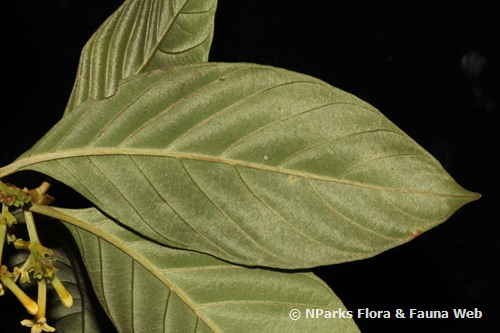
Back
Timonius wallichianus (Korth.) Valeton
| Family Name: | Rubiaceae |
| Synonyms: | Adina wallichiana, Timonius rumphii, Eupyrena hexasperma, Adina microphylla |
| Common Name: | Silver Timon, Triang, Berombong, Merombong, Tabah |
Name
Classifications and Characteristics
| Plant Division | Angiosperms (Flowering Seed Plants) (Dicotyledon) |
|---|---|
| Plant Growth Form | Tree |
| Lifespan (in Singapore) | Perennial |
| Mode of Nutrition | Autotrophic |
| Plant Shape | Irregular |
| Maximum Height | 7 m |
Biogeography
| Native Distribution | Peninsular Malaysia and Singapore |
|---|---|
| Native Habitat | Terrestrial (Secondary Rainforest, Riverine, Disturbed Area / Open Ground) |
| Preferred Climate Zone | Tropical |
| Local Conservation Status | Native to Singapore (Least Concern (LC)) |
Description and Ethnobotany
| Growth Form | It is a tree up to 7 m tall. |
|---|---|
| Foliage | Its opposite, stalked leaves have leaf blades that are lance-shaped, narrowed to both ends, hairless above but densely silvery hairy below, and 8.8 by 4.4 cm, with 7 pairs of veins. |
| Flowers | Plants are unisexual with individuals bearing only male or female flowers. Male flowers develop in stalked, axillary, many-flowered clusters. Female flowers develop in stalked axillary clusters of 3–5 flowers each. Its corolla (petal) is yellow and 0.74 cm long. Its calyx (sepal) is slightly round. In the flower of both sexes, the green, 4-lobed calyx is short-hairy and the yellow corolla has 4 lobes each. |
| Fruit | Its fruit is ellipsoid, 4-lobed, finely hairy, and about 9 mm long. Each fruit has pyrenes (seed covered by the hard inner fruit wall) that are slightly curved and linear-oblong. |
| Habitat | It grows in open country and at the edges of forests. |
| Associated Fauna | It is the preferred local food plant for caterpillars of the butterfly commander (Moduza procris), the adults of which usually lay their eggs singly at the leaf blade tip of the plant. The flowers are pollinated by butterflies and other insects. Its fruits are eaten and dispersed by birds. |
| Cultivation | It can be propagated by seed. |
| Etymology | Latin Timonius, a Malayan vernacular name; Latin wallichianus, commemorating Nathaniel Wallich (1786–1854), a Danish botanist and author |
Landscaping Features
| Landscaping | It is suitable for parks. |
|---|---|
| Desirable Plant Features | Ornamental Flowers |
| Landscape Uses | General, Parks & Gardens, Small Gardens |
Fauna, Pollination and Dispersal
| Fauna Pollination Dispersal Associated Fauna | Butterfly Host Plant (Leaves, Associated with: Moduza procris), Butterfly-Attracting |
|---|---|
| Pollination Method(s) | Biotic (Fauna) |
| Seed or Spore Dispersal | Biotic (Fauna) |
Plant Care and Propagation
| Light Preference | Semi-Shade, Full Sun |
|---|---|
| Water Preference | Lots of Water, Moderate Water |
| Plant Growth Rate | Moderate |
| Rootzone Tolerance | Moist Soils, Well-Drained Soils, Fertile Loamy Soils |
| Propagation Method | Seed |
Foliar
| Foliage Retention | Evergreen |
|---|---|
| Mature Foliage Colour(s) | Green |
| Mature Foliage Texture(s) | Velvety / Furry / Tomentose, Hairy / Hirsute, Raised / Sunken Veins |
| Foliar Type | Simple / Unifoliate |
| Foliar Arrangement Along Stem | Opposite |
| Foliar Attachment to Stem | Petiolate |
| Foliar Shape(s) | Non-Palm Foliage (Elliptical, Lanceolate) |
| Foliar Venation | Pinnate / Net |
| Foliar Margin | Entire |
| Foliar Apex - Tip | Acute |
| Foliar Base | Acute |
| Leaf Area Index (LAI) for Green Plot Ratio | 3.0 (Tree - Intermediate Canopy) |
Floral (Angiosperm)
| Flower & Plant Sexuality | Unisexual Flowers , Dioecious |
| Flower Colour(s) | White, Cream / Off-White, Yellow / Golden |
|---|
| Flower Grouping | Cluster / Inflorescence |
| Flower Location | Axillary |
| Flower Symmetry | Radial |
| Individual Flower Shape | Tubular |
Fruit, Seed and Spore
| Mature Fruit Texture(s) | Hairy / Hirsute |
|---|---|
| Fruit Classification | Simple Fruit |
| Fruit Type | Fleshy Fruit , Non-Accessory Fruit |
Image Repository
Others
| Master ID | 1898 |
|---|---|
| Species ID | 3191 |
| Flora Disclaimer | The information in this website has been compiled from reliable sources, such as reference works on medicinal plants. It is not a substitute for medical advice or treatment and NParks does not purport to provide any medical advice. Readers should always consult his/her physician before using or consuming a plant for medicinal purposes. |



